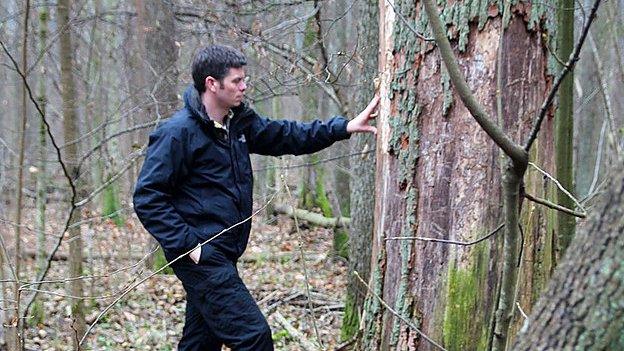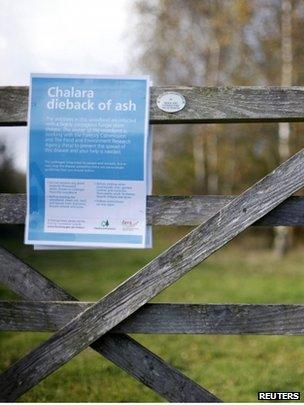Ash dieback: Chalara fungus 'originated in Asia'
- Published

An increasing body of evidence suggests that ash dieback - the disease which has killed trees across Europe and is now in Britain - originated in Japan.
Some scientists say the fungus now ravaging trees across Europe is the same as a native species from Japan.
However, the Asian version of the fungus seems to cause no harm to the local Manchurian ash trees there.
Researchers speaking to the Radio 4 programme The Tree Scientists described the misidentification of the fungus.
Recent figures from the Department for Environment, Food and Rural Affairs (Defra) show that there are almost 300 confirmed cases of ash dieback in Britain.
The fungus has spread across Europe over 20 years, threatening many of the continent's ash trees - and was first seen in nurseries in Britain in spring 2012.
The symptoms of ash dieback were first seen in Lithuania and Poland 20 years ago.
But it was not until 2006 that scientists identified that it was a fungus killing so many ash trees.
Prof Adam Hart, who presents The Tree Scientists, travelled to Poland to find out how scientists discovered what was happening.
Forest-felling fungus
Wloszczowa is a small town north of the mediaeval city of Krakow. It was here that forest rangers realised that the death of their ash trees was not being caused by frost damage, as had been previously assumed.
Artur Ratusznik, district forest manager for the region of Wloszczowa, decided to send samples to his former professor, Tadeusz Kowalski at the Agricultural University of Krakow, to see if he could identify what was killing the Ash trees.
"It all started when I was given affected samples from the nurseries in Wloszczowa," Prof Kowalski said.
"We could see the same symptoms in all the samples - there was a light centre at the site of infection, which is often where the branch grows out from the stem, then this was surrounded by a darker band - that's the plants defence fighting the infection. I managed to grow the fungus that was causing this infection in a Petri dish."
Prof Kowalski named the new fungal species Chalara fraxinea - but as the disease spread across the continent, he realised that something was not quite right.
"I couldn't quite put my finger on it; I couldn't see the whole picture," he said.
"I realised that Chalara fraxinea was just one stage in the life cycle of this fungus and that we were missing the other parts of this life cycle. So I decided to look more closely, and after searching and searching the forest floor near infected ash trees, I found something.
"But our initial identification of this new sample was wrong - this fungus was incredibly similar to an already commonly found fungus in Europe. But it couldn't be that one, so we had to look again - and eventually we got it."
Japanese origins
There is now more and more data emerging to show that Chalara fraxinea is not a European native species and could have come from Asia - including a recent paper in the journal Mycotaxon, external.

Infected tree numbers appear to have doubled in the UK in a month
Joan Webber, principal pathologist at the Forestry Commission, told the programme: "Scientists working together in Japan and Germany have been looking at a fungus associated with native ash trees in Japan. And what they've found is that this fungus appears to be the same one causing ash dieback in Europe and now in Britain."
So it seems that Chalara fraxinea originated in Japan or Korea, where it co-exists with native ash trees and does not appear to damage them.
Somehow the fungus has moved into Europe and as European native ash trees have not evolved with it, they are not resistant to its effects - and are dying in huge numbers.
Prof Kowalski agrees. He says the fungus is too deadly to have evolved in Europe.
"My colleagues and I have come to the conclusion that this fungus cannot be native - it's just far too aggressive," he said.
"Currently when it infects a nursery for instance, it kills all of the saplings, by killing its host it ultimately leads to its own demise and itself dies out. A successful fungus co-exists with its host tree, so they will both survive."
The Tree Scientists is on Radio 4 on Wednesday, 12 December at 11:00 GMT and will be available on iPlayer.